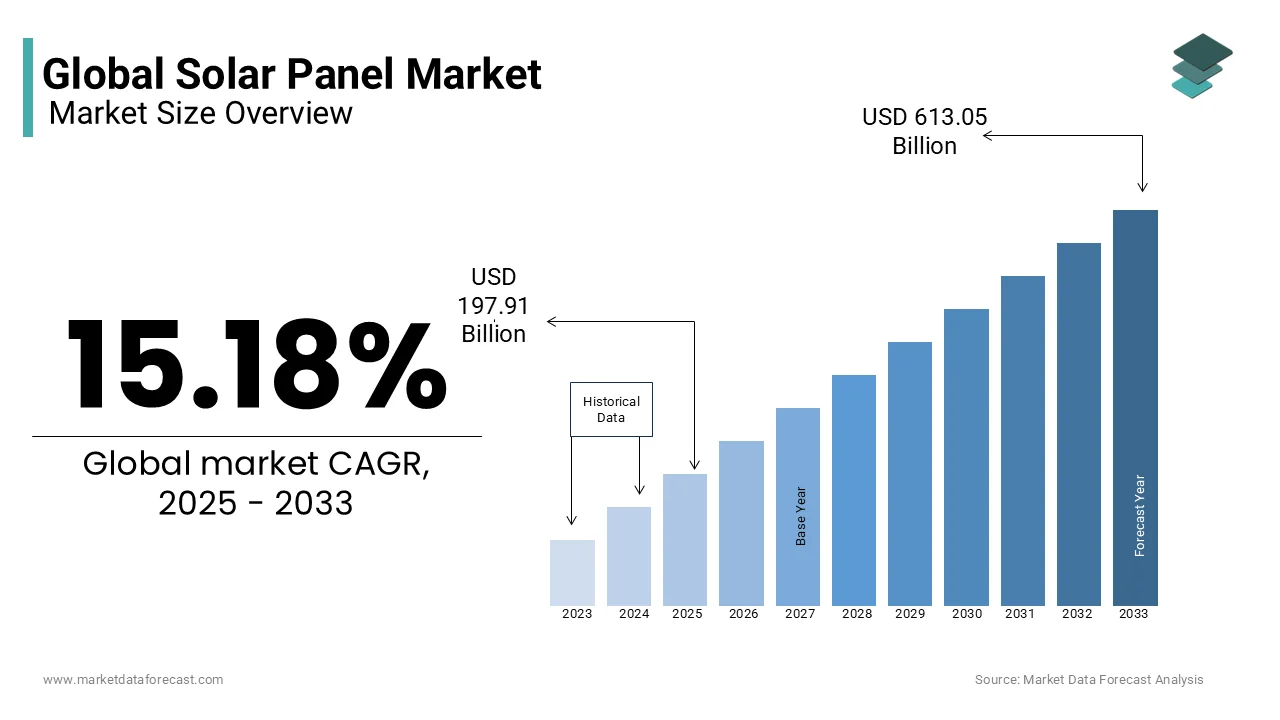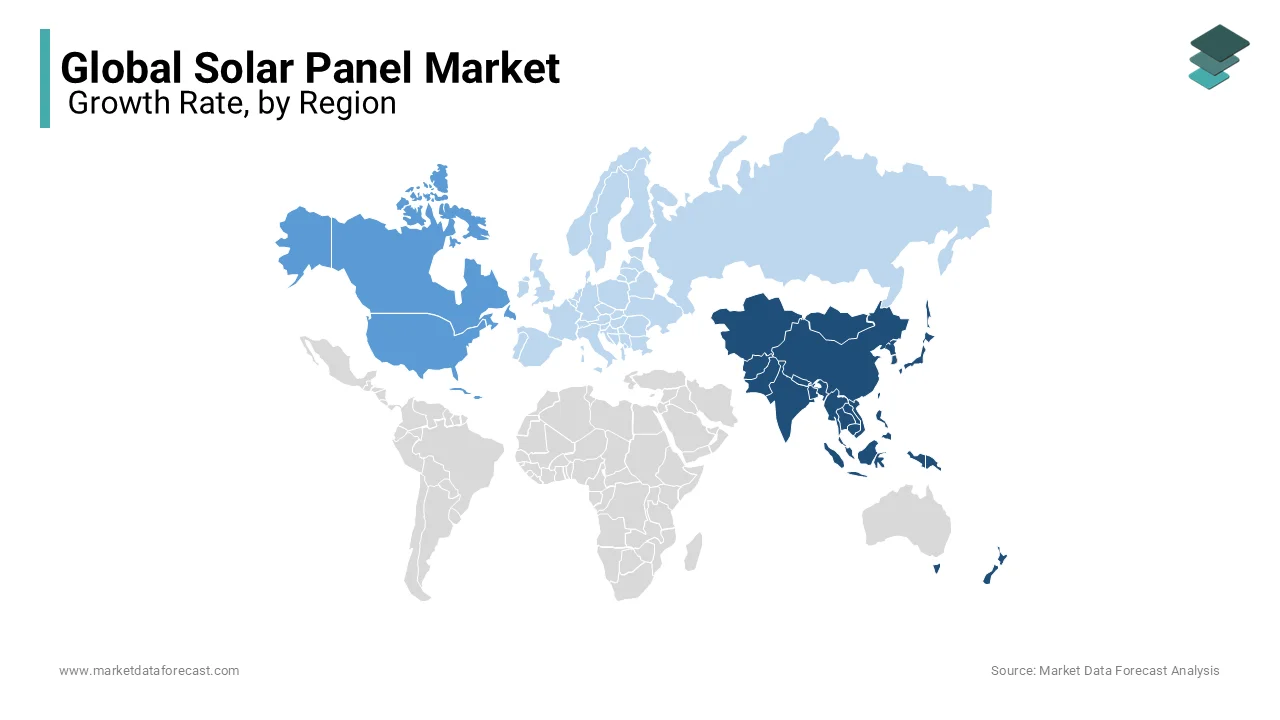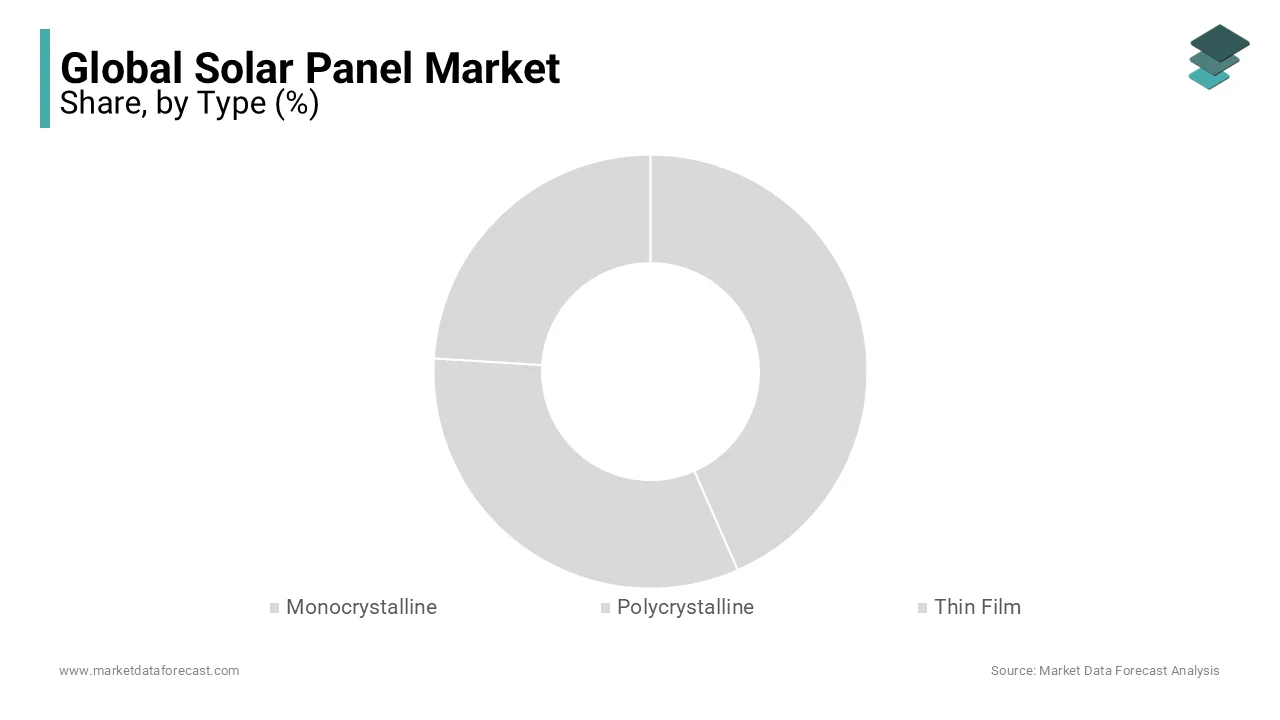Global Solar Panel Market Size, Share, Trends & Growth Forecast Report By Type (Monocrystalline, Polycrystalline, Thin Film), Application (Photovoltaic, Concentrated solar Power), End User (Residential, Commercial, Industrial, Utilities, Space & Defense, Others), Grid Type (On-grid, Off-grid) and By Region North America, Europe, Asia Pacific, Latin America, Middle East and Africa, 2024 to 2033
Global Solar Panel Market Size
The global solar panel market size is expected to grow at a CAGR of 15.18% during the forecast period 2025-2033. The market share was valued at USD 171.83 billion in 2024 and is expected to reach USD 613.05 billion by 2033 from USD 197.91 billion in 2025.

Producing electricity using sunlight is quietly possible using a photovoltaic (PV) module where such a device is called a solar panel. Solar energy has become one of the most powerful sources in recent eras as it is a renewable type of energy source. The use of solar energy capacity has been constantly growing for the past few years, with the rising prominence of fulfilling the demands from industries for continuous electricity without interruptions. Solar panels are becoming very interesting because of their huge benefits in promoting clean and green energy that reduces the impact of environmental pollution as they don't emit any harmful pollutants while generating electricity. The government's potential to increase the use of solar energy, especially in industrial areas, which is cost-effective, is likely to leverage the growth rate of the market in the coming years.
MARKET DRIVERS
The rising concern over carbon emissions is increasing the need.
The rising concern over carbon emissions is increasing the need to adopt renewable energy production globally. Both private and public companies are investing highly in the production of renewable energy, which is greatly influencing the growth rate of the market.
The trend to adopt renewable sources to produce energy is continuing globally. This factor is ascribed to accelerate the market value in the coming years. For instance, China invested around USD 83.4 billion in renewable resources in 2022, whereas the U.S. positioned second by investing USD 55.5 billion. The growing need to produce more energy with solar as a major renewable source is enhancing the demand for the solar panel market. For instance, the demand for solar panels has increased with the U.S. investments of over USD 5 billion to leverage the domestic solar panel manufacturing capacity by the end of 2024. In addition, the growing prominence of the clean energy sector is lavishing the market size. The U.S. and China are two major countries that contribute high investments in the clean energy sector. The investments in clean energy were approximately valued at USD 495 billion in 2022 globally, and the investment rate is expected to increase in the coming years. Stringent rules and regulations by government authorities to promote green energy targets are inclined to propose investments in the construction of solar panels in emerging countries across the world. Also, the rising popularity of launching floating solar technology and the installation of solar panels above the water infrastructure is escalating the market growth rate. China is one of the major countries that has already installed two novel floating solar technologies in Huainan City and Pei County. Even South Korea has installed this technology in many areas, such as Jipyeong, Otae, and Cheonpung Lake.
MARKET RESTRAINTS
Though the maintenance cost of solar panels is much less, the cost for the batteries to store the solar power is too high and is not affordable by the small and medium-scale industries, which may have a negative impact on the growth rate of the solar panel market. The cost of installing solar plants requires huge initial costs, which may also degrade the growth rate of the market. In addition to this, the lack of proper infrastructure for the installation of solar panels due to the lack of adequate support from the government authorities is likely to increase the growth rate of the market.
MARKET OPPORTUNITIES
The rapid adoption of the latest technology is to enhance the growth opportunities for the solar panel market in the coming years. The growing importance of nanomaterials in generating energy and levelling up the efficiency of solar cells is escalating the market growth rate to an extent. Growing competition between the key players and rising investments from government organizations to produce high-quality energy using renewable sources like solar energy are likely to promote market growth opportunities in the coming years. Focus on developing rural areas in developed countries is likely to promote the demand for the production of highly efficient energy.
MARKET CHALLENGES
The installation of solar panels requires a lot of space, and the difficulty in finding huge space, especially in urban areas, certainly poses great challenges for the market's key players. Solar panels occupy a huge space, and many people cannot install them due to the lack of space. However, many top companies are planning to launch innovative solar panels that occupy very little space and are compatible with today's world. This shall promote new opportunities for the market in the coming year
REPORT COVERAGE
|
REPORT METRIC |
DETAILS |
|
Market Size Available |
2024 – 2033 |
|
Base Year |
2024 |
|
Forecast Period |
2025- 2033 |
|
CAGR |
15.18% |
|
Segments Covered |
By Type, Application, End User, Grid Type, Region. |
|
Various Analyses Covered |
Global, Regional and Country Level Analysis, Segment-Level Analysis, DROC, PESTLE Analysis, Porter’s Five Forces Analysis, Competitive Landscape, Analyst Overview of Investment Opportunities |
|
Regions Covered |
North America, Europe, APAC, Latin America, Middle East & Africa |
|
Market Leaders Profiled |
Trina Solar Limited (China), Canadian Solar Inc. (Canada), Jinko Solar Holding Co. Ltd. (China), J.A. Solar Holdings Co. Ltd. (China), Hanwha Q CELLS Co. Ltd. (South Korea), ABROS Green GmbH (Germany), Yingli Solar (China), SunPower Corporation (U.S.A.), Abengoa Solar (Spain), eSolar Inc. (U.S.A.), and Others. |
SEGMENTAL ANALYSIS
By Type Insights
The thin film segment is leading with the dominant share of the market with the growing prominence for the installation of huge power plants using solar energy. The rising need to produce huge amounts of electricity using renewable energy is all set to elevate the growth rate of the market to an extent. Stringent rules and regulations by the government to adopt new systems that emit less or no harmful gases are additionally to fuel the growth rate of the solar panel market. The monocrystalline segment is next in leading the prominent share of the market during the forecast period. This is one of the most significant and effective types of solar panels that induce the production of a high amount of solar energy. Polycrystalline consists of several crystals of silicon in a single PV cell that produces conventional solar cells.
By Application Insights
The photovoltaic segment is gearing up to hold the largest share of the market. In recent times, the growing number of the latest techniques to produce high amounts of solar energy is attributed to the quick adoption of new systems in major industries like automation, automotive, healthcare, and others. This application converts direct sunlight into electricity by means of photovoltaic cells with varied characteristics. Concentrated solar power application is a traditional means of generating electricity using solar energy. This application uses lenses and mirrors that were installed in large areas to receive sunlight.
By End Use Insights
The residential segment is gaining huge traction over the market share. The popularity of solar panels in residential areas, especially in urban cities, is to elevate the growth rate of the market. The need to supply huge amounts of electricity in urban areas is quickly growing due to the increasing population. The need for electricity supply in agricultural fields is attributed to engraving the growth rate of the solar panel market to the extent. The space and defense segment shall create huge growth opportunities for the use of solar panels in the coming years. Solar power is becoming one of the most common uses in space and defense as it is renewable and emits very less harmful. The adoption of budget-friendly solar energy systems can enhance the growth rate of the solar panel market.
By Grid Type Insights
The on-grid segment is an engraving with the highest share of the solar panel market. This type is most commonly used to supply solar energy to residential buildings where the system is tied to the local utility grid for efficiency. Off-grid systems are connected to utilities that are located in other places and are managed differently. These systems are connected with internet access and can operated from anywhere.
REGIONAL ANALYSIS
Asia Pacific is thriving with a prominent share due to growing prominence to invest more in the renewable energy sectors. A growing population is one of the major factors for the growth of the solar panel market in the Asia Pacific region. The increasing population is raising the demand for the supply of electricity in many ways. Around 940 million people are facing power interruptions in the Asia Pacific, which is why the demand to generate more electricity using solar energy as the main source is rapidly increasing. It is expected that the demand for energy in the Asia Pacific will increase by 80% by 2040.

China is the major country in the world that produces high solar energy. In 2022, 392GW of solar capacity, whereas it is expected to install 500 GW by the end of 2023. It is about to reach the target of clean energy by adopting renewable sources to produce electricity that reduces greenhouse effects. India has witnessed the highest growth rate during the forecast period. The rising adoption of innovative technologies is majorly prompting the growth of the solar panel market in India. For instance, based on TOPCon technology, a bifacial solar panel was unveiled by Jackson in October 2023 at the Renewable Energy India Expo. This product has a tremendous efficiency of around 22.86%, which is expected to increase the demand for solar panels in the coming years. North America is next in leading, with the dominant share of the market and growing per capita income. Solar panels have become a huge source of electricity in North America, as around 36% of electricity is being produced with the help of solar energy. Approximately 230,000 Americans were employed in the solar industry as per data in 2021. The goal to obtain at least 10% of electricity using solar input is gearing the share of the solar panel market in North America. The U.S. and Canada are prominently playing major roles in escalating the demand for solar panels. With the growing demand to reduce greenhouse effects, some countries are coming up with innovative ideas to work against climatic changes. The U.S. department of energy (D.O.E.) Solar Energy Technologies Office (SETO) is supporting solar technology to fully adopt the decarbonized energy sector by 2050. Also, the National Renewable Energy Laboratory (NREL) is projected to provide more than 45% of electricity in the U.S. if the energy sector is decarbonized by 2050. Also, the use of solar panels is accelerating in the residential sector. It was estimated that almost 3.5 million homes have already installed solar panels, whereas the United States is completely relying on 3.5% of solar energy production. Europe's solar panel market is likely to have a prominent growth rate during the forecast period.
KEY PLAYERS IN THE MARKET
Companies playing a promising role in the global solar panel market include Trina Solar Limited (China), Canadian Solar Inc. (Canada), Jinko Solar Holding Co. Ltd. (China), J.A. Solar Holdings Co. Ltd. (China), Hanwha Q CELLS Co. Ltd. (South Korea), ABROS Green GmbH (Germany), Yingli Solar (China), SunPower Corporation (U.S.A.), Abengoa Solar (Spain), eSolar Inc. (U.S.A.), and Others.
RECENT HAPPENINGS IN THE MARKET
- In 2023, Canadian Solar is all set to establish a 5GW module production facility in Texas by deploying Topcon solar technology. With an investment of USD 250 million, the company is stabilized to produce 20,000 high-power modules daily.
MARKET SEGMENTATION
This global solar panel market research report has been segmented and sub-segmented based on type, application, end-user, grid type, and region.
By Type
- Monocrystalline
- Polycrystalline
- Thin Film
By Application
- Photovoltaic
- Concentrated solar power
By End User
- Residential
- Commercial
- Industrial
- Utilities
- Space & Defense
- Others
By Grid Type
- On-grid
- Off-grid
By Region
- North America
- Europe
- Asia Pacific
- Latin America
- Middle East & Africa
Frequently Asked Questions
1. What is the Solar Panel Market growth rate during the projection period?
The Global Solar Panel Market is expected to grow with a CAGR of 15.18% between 2025-2033.
2. What can be the total Solar Panel Market value?
The Global Solar Panel Market size is expected to reach a revised size of USD 613.05 billion by 2033.
3. Name any three Solar Panel Market key players?
SunPower Corporation (U.S.A.), Abengoa Solar (Spain), and eSolar Inc. (U.S.A.), are the three solar Panel Market key players.
Related Reports
Access the study in MULTIPLE FORMATS
Purchase options starting from $ 2500
Didn’t find what you’re looking for?
TALK TO OUR ANALYST TEAM
Need something within your budget?
NO WORRIES! WE GOT YOU COVERED!
Call us on: +1 888 702 9696 (U.S Toll Free)
Write to us: [email protected]
